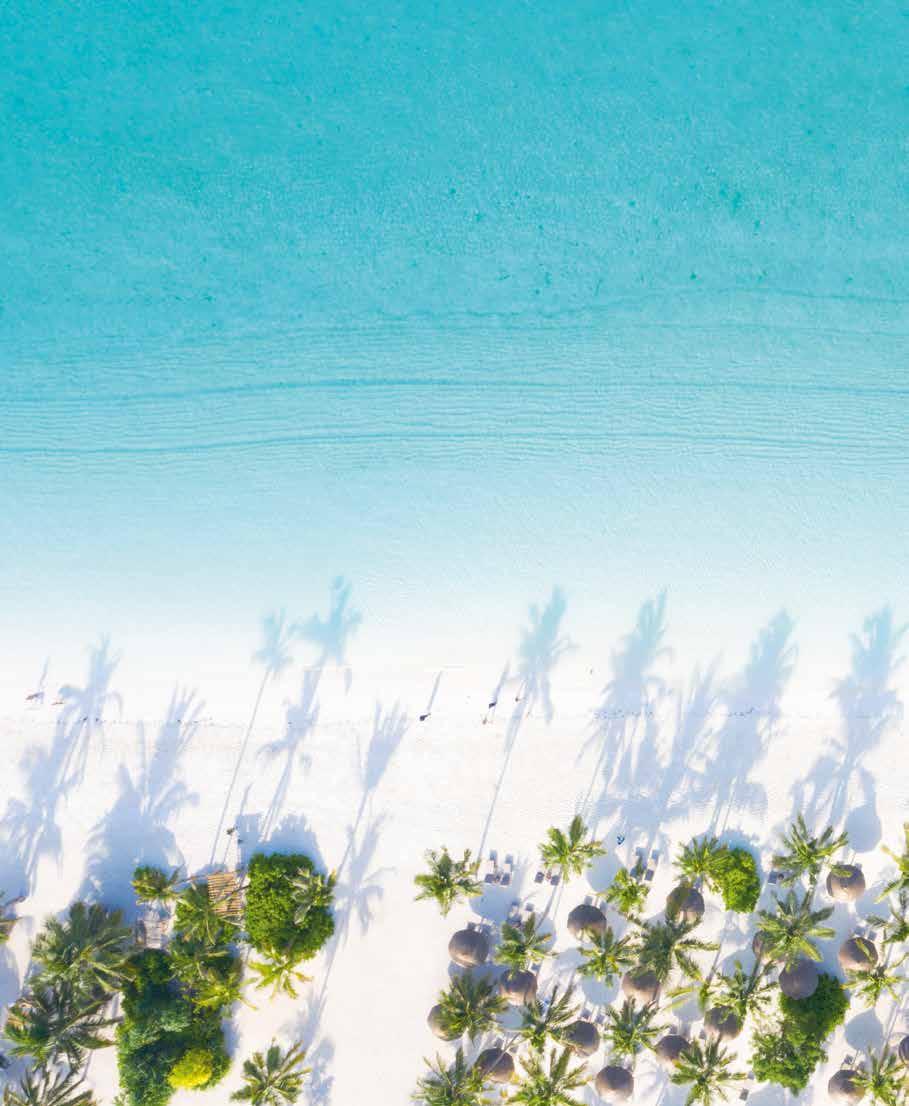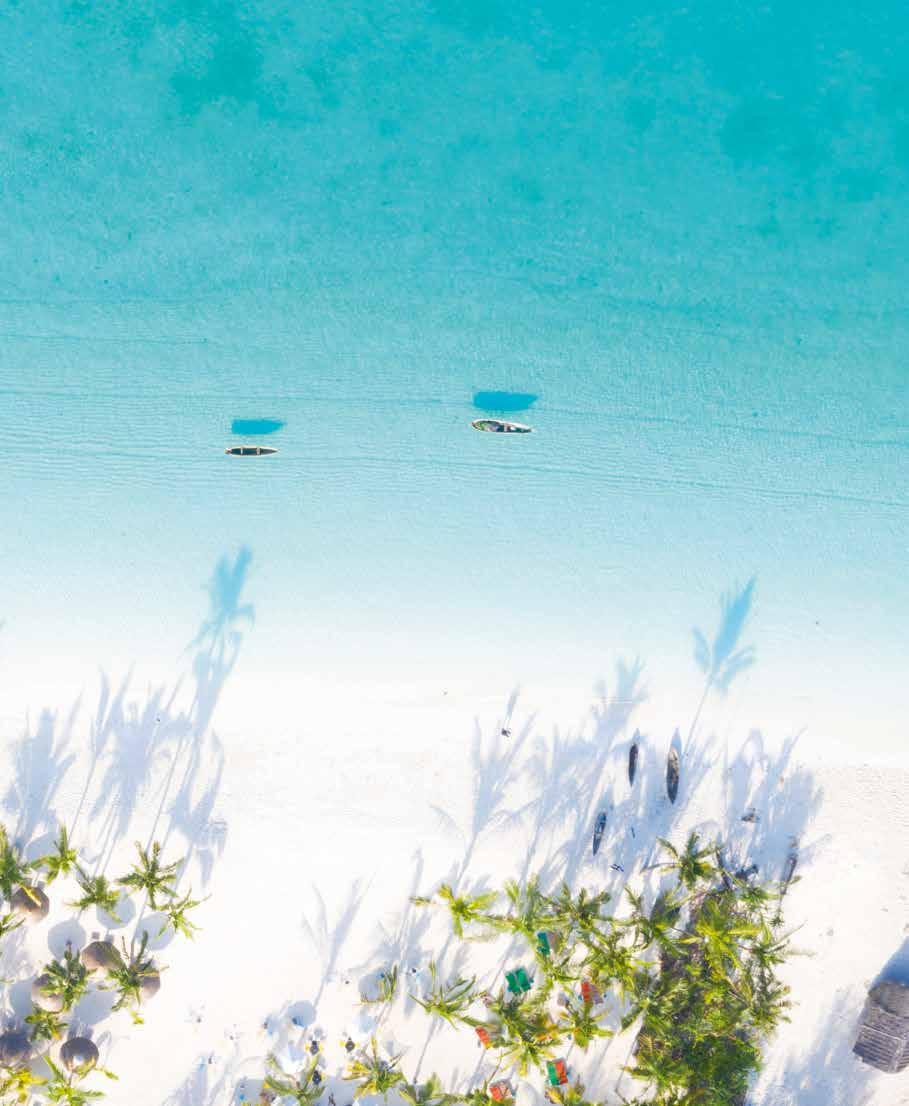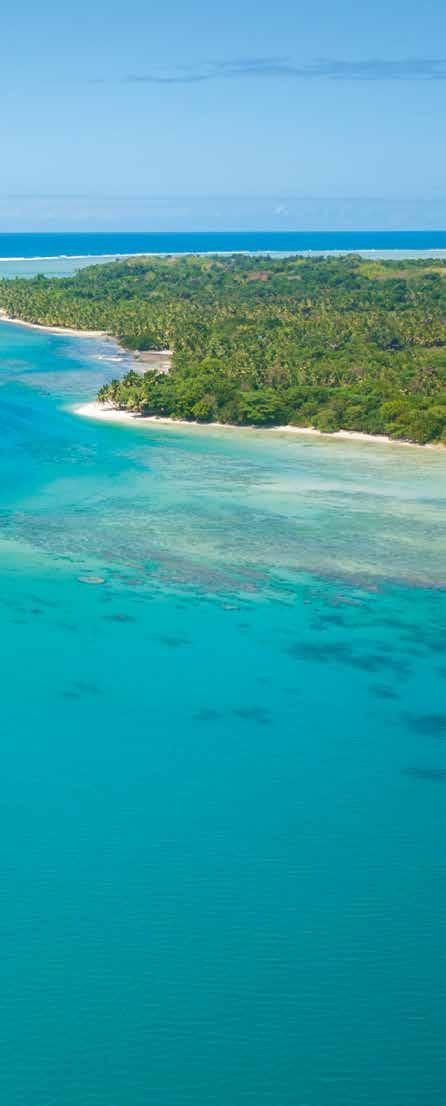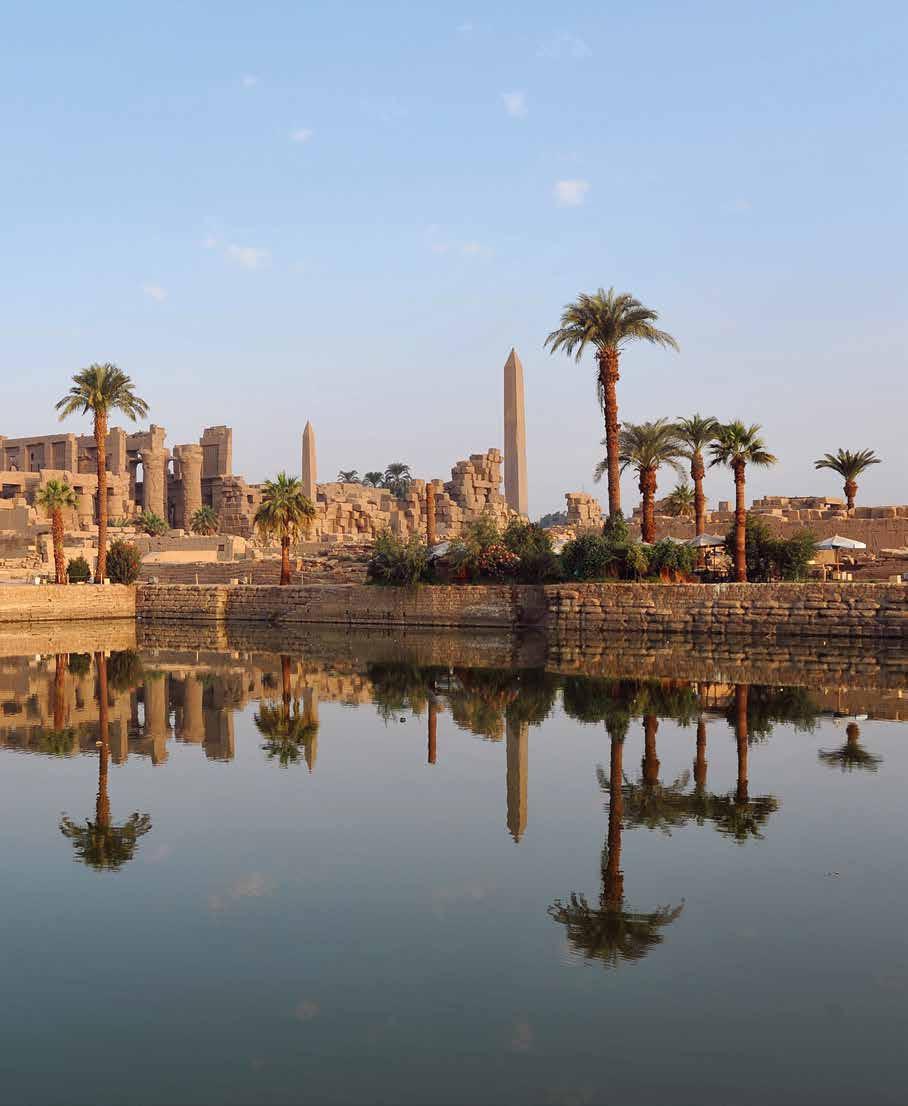AFRICA



Mauritius
While the most popular vacation plan in Africa will probably forever remain the safari, the Mother Continent also boasts some incredible beaches. One of its most picturesque is Flic-en-Flac, a seaside village on the west coast of Mauritius—a spot so beautiful we think it’s book cover–worthy (wink, wink). The great American writer Mark Twain seems to agree—in an 1896 travelog, he wrote of Mauritius: “This is the only country in the world where the stranger is not asked ‘How do you like this place?’ … Here the citizen does the talking about the country himself; the stranger is not asked to help. … From one citizen you gather the idea that Mauritius was made first, and then heaven; and that heaven was copied after Mauritius.”
The island of Mauritius is an East African country in the Indian Ocean boasting the best of all worlds; it has a lush mountainous interior with waterfalls, wildlife, and rainforests just begging to be hiked as well as stunning beaches and lagoons. Offshore, the reefs of Mauritius offer prime snorkeling and diving opportunities as well as serene protected lagoons; in the southwestern region, Black River Gorges National Park has nearly 40 miles of hiking trails through upland forest, lowland forest, and heathland. Its greenscapes are just as striking as the beautiful blue waters off its palm tree–lined shores.
First discovered by Arab sailors around the year 975, Mauritius has no Indigenous population. Today, its major ethnic groups are Hindus, Muslims, Creoles, Franco-Mauritians, and Chinese, but the island has seen Dutch, French, and British rule following the Portuguese arrival in 1507. In 1968, Mauritius declared independence from the United Kingdom, and in 1992, it became the Republic of Mauritius.
As beautiful as the island is, acknowledging its darkness is important, too. One place to do this is Aapravasi Ghat, a UNESCO Cultural Heritage Site; this complex was an immigration depot when the British government opted to use Mauritius as the initial site of its “great experiment” of using indentured laborers from India. This early manifestation of what eventually became a tragic global economic system now invites reflection, as does the other UNESCO Cultural Heritage Site on Mauritius, Le Morne Brabant, where runaway slaves took refuge. This natural monument at the southwestern tip of the island is now a symbol of resistance; legend has it that in 1835, following the abolition of slavery in Mauritius, escapees saw a dispatch of police coming their way and assumed they were being arrested—rather than informed of their legal emancipation—and jumped to their deaths to evade recapture.
ITS GREENSCAPES ARE JUST AS STRIKING AS THE BEAUTIFUL BLUE
WATERS OFF ITS PALM TREE–LINED SHORES





Zanzibar
Form a mental picture of Africa and, for most people, what comes to mind is the swaying grasslands of the Serengeti Plain or perhaps the golden desert sands of the Sahara. However, white-sand beaches lapped by soft-blue waters are just as much a part of the African landscape as any arid ecosystem. For some of the prettiest tropical scenes in Africa, you’ll have to go just offshore—to an archipelago off the coast of Tanzania, to be precise.
Located in East Africa, Tanzania is known primarily for three things: Serengeti National Park, Mount Kilimanjaro, and Zanzibar. The semi-autonomous territory of Zanzibar is an assemblage of many small islands and two large ones (the main island of Unguja and Pemba Island). Many people are referring specifically to Unguja when they say Zanzibar, but in reality, Zanzibar is a medley of islands. Zanzibar has a political union with Tanzania but has its own parliament and president, with an economy reliant mainly on spices (particularly cloves, nutmeg, cinnamon, and black pepper) and tourism.
In Zanzibar City, the capital, expect to find amazing architecture ranging from Arabian arches to minarets, carved doorways, and Omani palaces, as well as the winding lanes of the old section of the city. Stone Town, which has both Swahili and Islamic influences, is the historic center of trade. The town is named for its widespread use of coral stone as a construction material. It’s worth exploring for a day or two before heading to the famous beaches of Zanzibar. Or, build it into your
itinerary: while you can take a short flight from Dar es Salaam to Zanzibar, another option is to take the ferry, which connects the mainland to Zanzibar by sea and concludes in Stone Town.
Just because Zanzibar is an island separate from mainland Tanzania—the epitome of safari country— doesn’t mean it’s without its fair share of must-see wildlife. Dive under the sea and you’ll encounter a rainbow of colorful reef fish; head to Jozani Chwaka Bay National Park, the only national park in Zanzibar, or any of the island’s wildlife reserves for a chance to spot the Zanzibar red colobus monkey, a critically endangered species endemic to the island of Unguja. These adorable fluffy primates have faced severe habitat destruction as well as hunting for consumption and in retribution for crop damage.
Still, the main attraction of Zanzibar is undoubtedly its stunning beaches. Nungwi Beach, Paje Beach, Kendwa Beach, and Kizimkazi Beach—where you’re practically guaranteed to spot wild bottlenose dolphins—are among the most popular.

ZANZIBAR, TANZANIA


DIVE UNDER THE SEA AND YOU’LL ENCOUNTER A RAINBOW OF COLORFUL REEF FISH
 ZANZIBAR, TANZANIA
ZANZIBAR, TANZANIA

Madagascar
Made famous in the Western world by the 2005 computer-animated film of the same name, Madagascar is no hidden gem: around 28 million people call this Indian Ocean island nation home. Located off the coast of southern Africa, Madagascar is the second-largest island country (after Indonesia) and the fourth-largest island in the world.
Unfortunately, it’s also home to one of the world’s highest poverty rates, despite its natural wealth of resources and desirable destinations. Around threefourths of the island’s citizens live in extreme poverty, with Madagascar’s particular vulnerability to natural disasters like floods, cyclones, and drought leading to food insecurity and worse. The country has suffered from environmental issues, governmental corruption, poor infrastructure, limited educational opportunities, overpopulation, and a dearth of jobs; perhaps unsurprisingly, tourism numbers are low, despite all there is to see and do in this beautifully biodiverse country.
With that in mind, a vacation to Madagascar shouldn’t be written off—but it should be considered alongside ways to contribute instead of just consume. Visitors can donate to local development organizations, where funds go a long way. Avoid handing out gifts to local children directly; book with a local, reputable tour operator; and support locally owned restaurants and shops. Generous tipping to drivers, guides, and staff is also a welcome gesture.
For the conscientious, adventurous traveler, Madagascar’s famous lemurs, mind-boggling baobab trees, and wildlife-filled jungles await like a treasure trove of Mother Nature. After a trek to the hard-toreach, forbidding, but jaw-dropping Tsingy de Bemaraha National Park or hiking the rugged cliffs, ravines, gorges, and canyons of Isalo National Park, you’re going to want nothing more than a lazy beach day—and Nosy Be is just the place for that.
Nosy Be is a small island located five miles off the northwestern coast of Madagascar. It’s one of the country’s premier tourism hotspots thanks to its volcanic lakes, rum distilleries, restaurants, resorts, and unbeatable beaches. Off the northeastern coast, for a quieter option, there’s Île Sainte-Marie, where many pirates are laid to rest (and where some of the spoils of the 17th century’s most famous pirate, Captain Kidd, were found); if gentle giants are more your speed, whale watching here is unparalleled.
Madagascar is a choose-your-own-adventure for the intrepid tourist, but it’s important to keep in mind that every dollar you spend has a far-reaching impact—and that real life is never quite as idyllic as it appears in the movies.

MADAGASCAR IS A CHOOSE-YOUR-OWNADVENTURE FOR THE INTREPID TOURIST


Luxor
Luxor is arguably one of the most stunning locations in Egypt, but that’s nothing new: ever since it was the ancient city of Thebes, the capital of the pharaohs beginning in the 16th century BC, it has been a globally significant location.
Located in southern Egypt on the eastern bank of the Nile River, the city is oriented around two massive monuments that date back to approximately 1400 BC. The first is the sandstone-crafted Luxor Temple, dedicated not to a god or deified pharaohs (as most temples are) but to “the rejuvenation of kingship,” as it was the location of many pharaoh crownings over the centuries. Luxor Temple was the most significant religious center in ancient Egypt since, according to ancient writings, the god Amon experienced “rebirth” here during the pharaoh’s coronation ceremony, which was reenacted on an annual basis.
The second, equally significant in ancient Egyptian culture, is the Temple of Karnak. Tied perhaps with Angkor Wat (scholars cannot seem to definitively agree), it is the largest religious complex ever constructed and is the second-most-visited destination in Egypt after the Great Pyramids of Giza, even though it is only partially open to the public. Beginning in the year 2000 BC, a series of about 30 pharaohs each added something to the temple complex, whether additional temples or other monuments or buildings, and their long legacy of additions has made it the impressively large site it remains today.
Dotting the area and adding a bit of color to the seemingly ceaseless golden browns are plentiful palm trees, a traditional feature of Egyptian desert landscapes. To take it all in from perhaps the most scenic spot in town, book a sunset cruise on the Nile aboard a traditional felucca sailing boat. These simple boats have navigated the Nile since the dawn of time, and experiencing this one-of-a-kind mode of ancient transportation is a must on any visit to Luxor.
Across the Nile, on the river’s west bank, sit the royal tombs of the Valley of the Kings and the Valley of the Queens. In Luxor, you can’t go far without bumping into an important archaeological site that can trace its history back almost as far as the human imagination can venture. The whole scene feels like an impossibility: an oasis in the sand, a portal to a land before time—but in our modern world, it’s all just a plane ride away.
